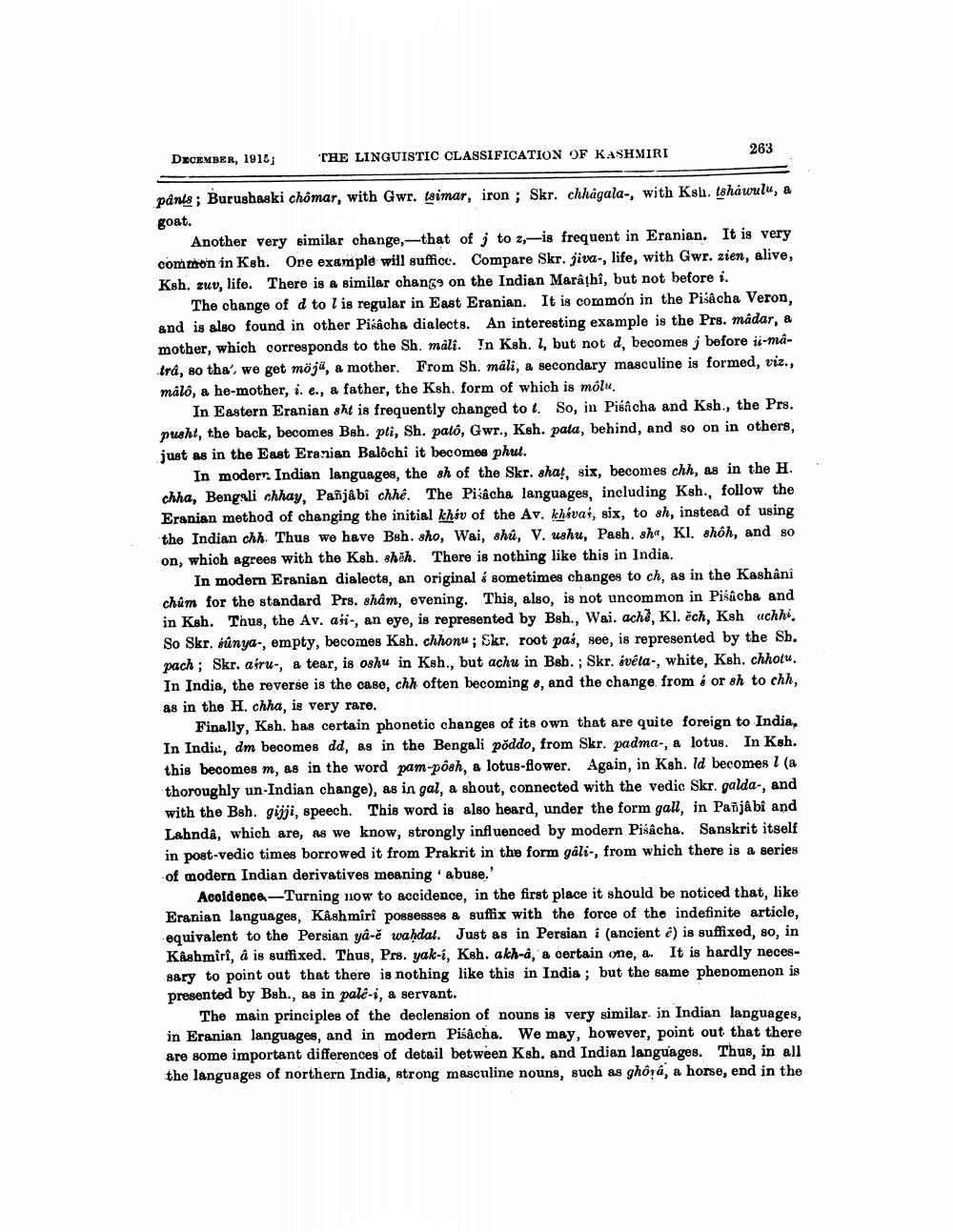________________
DECEMBER, 1910)
THE LINGUISTIC CLASSIFICATION OF KASHMIRI
263
pants; Burushaski chômar, with Gwr. tsimar, iron; Skr. chhagala-, with Ksh. tshawulu, a goat.
Another very similar change that of j to 2,- is frequent in Eranian. It is very common in Ksh. One example will suffioc. Compare Skr. jiva-, life, with Gwr. zien, alive, Ksh. zuv, life. There is a similar change on the Indian Marâțhi, but not before i.
The change of d to l is regular in East Eranian. It is common in the Pišâcha Veron, and is also found in other Pikacha dialects. An interesting example is the Prs. madar, a mother, which corresponds to the Sh. máliIn Ksh. 1, but not d, becomes before ii-matra, so tha', we get möja, a mother. From Sh. máli, a secondary masculine is formed, viz., máló, a he-mother, i.e., a father, the Ksh. form of which is mólu.
In Eastern Eranian sht is frequently changed to t. So, in Pisa cha and Ksh., the Prs. pusht, the back, becomes Beh. pti, Sh. pato, Gwr., Ksh. pata, behind, and so on in others, just as in the East Eranian Balochi it becomes phut.
In modern. Indian languages, the sh of the Skr. shat, six, becomes chh, as in the H. chha, Bengali chhay, Pañjâbi chhé. The Pišâcha languages, including Ksh., follow the Eranian method of changing the initial kháv of the Av. khắvas, six, to sh, instead of using the Indian chh. Thus we have Bsh. sho, Wai, shú, V. ushu, Pash, sha, Kl, shoh, and so on, which agrees with the Ksh. shēh. There is nothing like this in India.
In modern Eranian dialects, an original é sometimes changes to ch, as in the Kashânî chùm for the standard Prs. sham, evening. This, also, is not uncommon in Pisacha and in Ksh. Thus, the Av. asi, an eye, is represented by Bsh, Wai, achi, Kl. čch, Ksh uchhi. So Skr. súnya-, empty, becomes Ksh. chhonu ; Skr, root pas, see, is represented by the Sb. pach ; Skr. afru-, a tear, is oshu in Ksh., but achu in Bsb.; Skr. sveta-, white, Ksh. chhotu. In India, the reverse is the case, chh often becoming 8, and the change from 6 or 8h to chh, as in the H. chha, is very rare.
Finally, Ksh. has certain phonetic changes of its own that are quite foreign to India, In India, dm becomes dd, as in the Bengali põddo, from Skr. padma., a lotus. In Ksh. this becomes m, as in the word pam-pôsh, a lotus-flower. Again, in Ksh. ld becomes 1 (a thoroughly un-Indian change), as in gal, a shout, connected with the vedic Skr. galda-, and with the Bsh. gijji, speech. This word is also heard, under the form gall, in Panjabi and Lahnda, which are, as we know, strongly influenced by modern Piśâcha. Sanskrit itself in post-vedic times borrowed it from Prakrit in the form gáli-, from which there is a series of modern Indian derivatives meaning abuse.'
Acoidence-Turning how to accidence, in the first place it should be noticed that, like Eranian languages, KÅshmîrî possesses & suffix with the force of the indefinite article, equivalent to the Persian yâ-ě wahdat. Just as in Persian i (ancient é) is suffixed, so, in Kashmiri, & is suffixed. Thus, Prs. yak-i, Ksh. akch-a, a certain me, a. It is hardly necessary to point out that there is nothing like this in India ; but the same phenomenon is presented by Bsh., as in pale-i, a servant.
The main principles of the declension of nouns is very similar in Indian languages, in Eranian languages, and in modern Pisacha. We may, however, point out that there are some important differences of detail between Ksh, and Indian languages. Thus, in all the languages of northern India, strong masculine nouns, such as ghora, a horse, end in the




